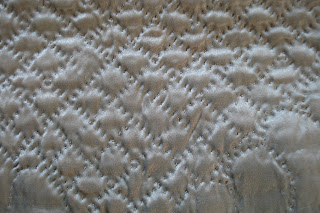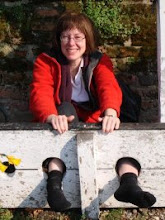 I still have a few quilts that I have not posted about that I will share with you. However, from time to time I am going to republish some of the older posts about my "better" quilts, as I think that there are still some readers out there who may not have seen these quilts.
I still have a few quilts that I have not posted about that I will share with you. However, from time to time I am going to republish some of the older posts about my "better" quilts, as I think that there are still some readers out there who may not have seen these quilts. The quilting is very fine on this quilt and the designs are a bit out of the ususal.
The quilting is very fine on this quilt and the designs are a bit out of the ususal.


Margaret was also known as Mrs James Williams. She was a well-known quilter from Gwaun-cae-Gurwen, South Wales near Landeilo. I bought this quilt from a dealer in 2006, and as it was bought at auction it had no provenance. The date was thought to be 1930’s. A number of my Welsh quilts toured with Grosvenor Exhibitions to their quilt fairs, and I was overjoyed when Claire Claridge saw the quilts at Malvern and identified this quilt as being one of Margaret’s, or to her design by one of her students.
The quilt measures 85 x 93” and is bright yellow on the reverse and a pale apple green on the right side ( a bit faded, this side). The wadding is carded wool. It is in good condition and not worn. There are some good patterns on this quilt and the quilting is lovely.
Margaret is featured on page 140 in the book Quilt Treasures, as is one of her quilts. And on page 102 of Making Welsh Quilts, you can see photos of another of her quilts (the pink and white quilt - not the grey one). The central motif, looking like a lovers knot but actually double hearts or a series of double loops, is very similar to the one shown on page 103 fig 88 in Quilt Treasures. And very characteristic are the asymmetric spirals in pairs - known as ram’s horns. She also favoured stars. In other quilts, she also used natural-looking leaves, and also not seen here, a vine with a single stem, simple leaves and a spirals for flowers (See MWQ). Also seen in this quilt are bent leaves, spirals, grids and simple leaf or fern patterns.
Margaret made and sold quilts to order, and she was proud that some went to the nobility. She also gave quilting demonstrations, taught quilting classes, was a home nurse and iced wedding cakes. She won numerous prizes for quilting at various Eisteddfodau in the 20’s and 30’s.
In Wales, quilting was generally a paid profession. Women made quilts for pay. These women did not generally sign their work and the quilts are now anonymous - so it is very interesting when you do know the quilter’s name. Clare is very interested in researching these quilters - some of my quilts do have provenance and some day I hope to be able to learn how to track down more detail about the quilters.









































